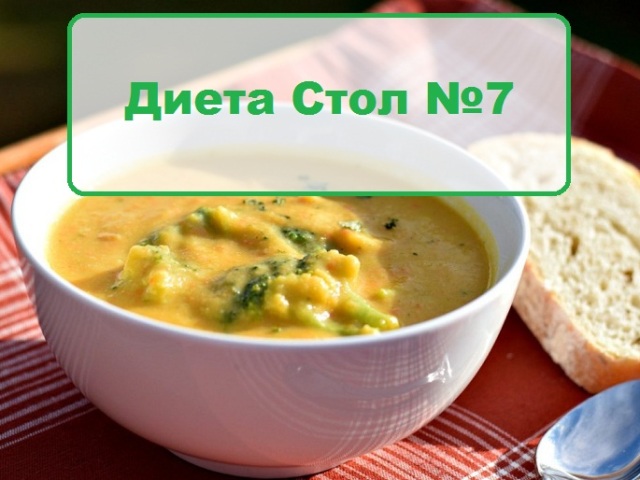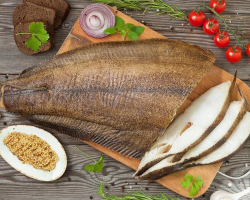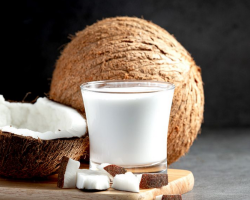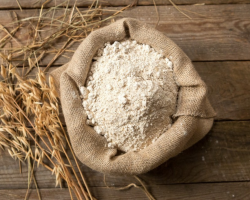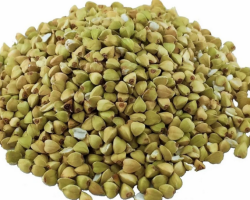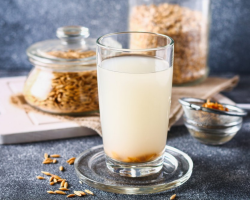In this article, we will consider the basis of diet No. 7, which is required for kidney diseases in order to speed up the patient recovery and improve metabolism in the body.
Content
- Diet table No. 7: Indications for the appointment
- Diet table No. 7: the main features, the table of nutrients
- Diet table No. 7: a list of permitted and prohibited products
- Diet table No. 7: tips
- Diet table No. 7: an approximate menu for a week and for every day
- Diet table No. 7: recipes for popular dishes
- Video: Diet table No. 7
Any diseases primarily require patients to comply with a certain diet! Just each species is based on certain aspects that are as selected as possible for a specific ailment. In this article, we will consider precisely the case of a diet during malnutrition systems. It is she who can reduce the risk of early death in people with chronic kidney diseases (HBP). Therefore, nephrologists and nutritionists are increasingly prescribing a therapeutic diet of table No. 7 to their patients.
Diet table No. 7 removes swelling and helps to restore the water-salt balance. If you adhere to the diet in series, then it positively affects the tolerance of dialysis therapy and, therefore, the quality of life of the patient.
Diet table No. 7: Indications for the appointment
Diet table No. 7 is assigned to people with kidney diseases, such as:
- acute and chronic nephritis
- inflammation of the renal corpuscles (glomerulonephritis)
- kidney damage due to sugar disease (diabetic nephropathy)
- pyelonephritis or inflammation of the renal intermediate tissue
- swelling of the legs
- nephropathy in pregnant women
- obesity and a malfunction in metabolism
At the same time, this diet is prescribed at such stages of the disease:
- easy renal failure
- moderate renal failure
- progressive renal failure
- decompensated renal failure or with a complete loss of kidney functionality
Important: a diet can be sparing or more rigid depending on the stage of the disease. It has a classification by alphabet from A to G, depending on the severity of the disease. The most strict is the first category.
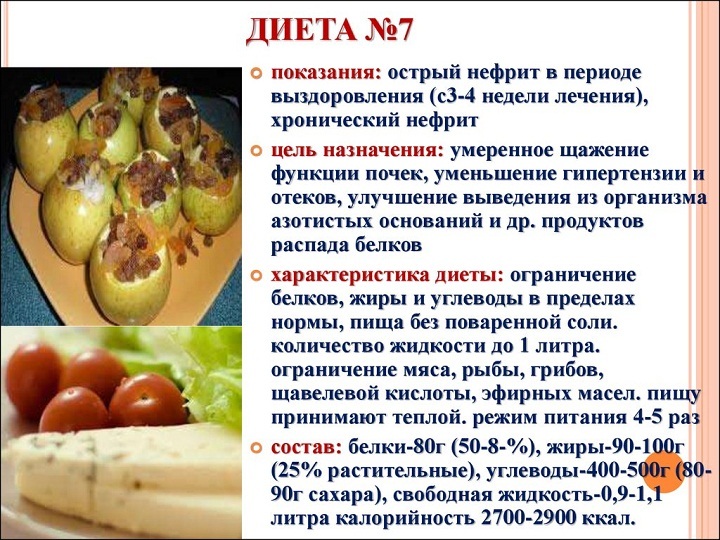
Diet table No. 7: the main features, the table of nutrients
In short, diet table 7 is a healthy diet that is rich in fruits, vegetables, cereals, whole grain products and fiber, as well as a low content of red meat, salt and refined sugar. After all, its task is to reduce the load on the kidneys.
This low -white diet, Adapted to the severity of the disease is the basis of treatment. In this case, a prerequisite is the absence of salt and all products that contain sodium in the diet. Another important aspect is reducing fluid consumptionin any form.
- The amount of liquid It must be agreed with the attending physician. But depending on the degree of the disease, it is allowed to consume from 800 ml to 1.5 liters per day.
- Number of calories You should also agree with a nephrologist or nutritionist. On average, it is allowed to use no more than 2900 kcal, but not less than 2100-2200. At the same time, they pay attention to physical activity and regime of the patient's day.
- Recommendations in the diet at the table No. 7: Nephrologists and nutritionists recommend eating up to 5 times a day, that is, every 3 hours. The amount of food should be small.
The duration of the diet No. 7 must be determined by the attending doctor!

Diet composition:
Traditionally, patients with CBP are limited in individual nutrients, such as phosphorus, salt, potassium and protein. These restrictions prevent complications in kidney diseases.
- Sodium It is important because it helps to regulate the balance of fluid in the body. However, patients with chronic kidney disease and dialysis reduce/lose the ability to balance sodium and water in the body. For this reason, people with chronic kidney disease are recommended to reduce sodium consumption to about 1500 mg (1.5 g) - 2300 mg (2.3 g) per day. For comparison:
- 1/4 teaspoon of salt \u003d 500 mg sodium
- 1/2 teaspoon of salt (1 teaspoon of baking soda) \u003d 1000 mg of sodium
- 3/4 teaspoon of salt \u003d 1500 mg sodium
- 1 teaspoon of salt \u003d 2000 mg sodium
- Excessive consumption of sodium in the renal dietTable number 7 It can lead to many harmful complications, including hypertension (high blood pressure), cardiovascular (cardiac) diseases and congestive cardiac failure. In addition, swollen ankles, swollen eyes and difficulty breathing can be a side effect of increased sodium consumption, since patients may need hydration leading to fluid overload.
Therefore, it should be limited to an absolute minimum - the consumption of salt, acute spices, including pepper.

- Squirrels in the diet table number 7.Products with an adequate level of animal protein should be included in the diet. Until recently, protein was not allowed with kidney diseases. However, recent studies have shown that a low protein diet allows the kidneys to restore. The optimal protein volume from 20 to 80 g. Its size can be increased due to vegetable proteins, but also no more than half of the recommended dose. With diet No. 7, meat and fish are completely excluded!
- Carbohydrates It is necessary for the body in the amount of 350-450. But this dose is not achieved due to sweets.
- Fat in diet No. 7.The optimal dose is from 40 to 110, which also depends on the severity of the disease, the average value of diet No. 7 is 80 g.
- Decrease potassium It is only necessary if its content in the blood increases. The average permitted indication of potassium up to 4.4 g, but in the case of progressive renal failure, the daily potassium consumption should be about 2 g.
- Phosphorus Reduces to a mark of 1.6 g per day.
- In addition, you should follow calcium, Which varies about 1 g per day.
- Proteins occupy from 20 to 80 g.
- Lipids Based on 70-90 g, 25% of which is occupied by a group of plant origin.
Comparison table
| Type of diet | The amount of fat, g | Number of proteins, g | The amount of carbohydrates, g | The number of calories | Salt, g | Amount of water, ml | Additional food processing (grinding, grinding) |
| 7a | 80 | No more than 20 | 300–350 | No more than 2200 | Full refusal | 800 | Required |
| 7b | 85–90 | 40–50 | 400–450 | 2500–2600 | 1–5 | 1000-1500 | Not required |
| 7v | 80–90 | 100–120 | 300–350 | 2100–2700 | 1–3 | 1000 | Not required |
| 7g | 90-100 | 60 | 400-450 | 2500-2800 | 1-2,5 | 600 | Not required |
Diet table No. 7: a list of permitted and prohibited products
Let's start with the fact that the diet is prohibited by the table No. 7:
- Of course, you can't eat with a diet fast food Or any quick cooking, potato chips! But you should also be careful With broths, Especially mushroom.
- Any should be excluded smoked productsby type of sausages and ham, as well as Mushrooms and solid, flooded cheese!
- Full ban on Fatty varieties of meat and fish, offal and caviar.
- Besides, On legumes and sour/bitter vegetables.For example, a radish, turnip, sorrel, spinach, as well as onions and garlic. In addition, it is worth noting greens, What contains a greater concentration of essential oils is celery, parsley and Pasternak.
- Except forbidden salt some should be avoided salted products, such as: pickles, canned food, sauer products, salted herring and other salting, anchovies, broth cubes.
- Products rich potassium, such as dried fruits, bananas, nuts and chocolate, should be stored as far as possible.
- Unsuitable drinksat diet Table number 7 are: fast -soluble drinks, milk, as well as wine and beer. Strong coffee, cocoa and all alcohol and carbonated drinks, energy!
- Speaking About fats, That spread, margarine, as well as pork or goose fat fall under the strictest taboo!
- You can't eat mayonnaise, Especially store production. It is worth highlighting more mustard, adjika and ketchup, And also any sauces!
- It is worth limiting Cream and sour cream!
- It is worth deleting their list yeast bread and generally all confectionery pastries, sweets and ice cream.
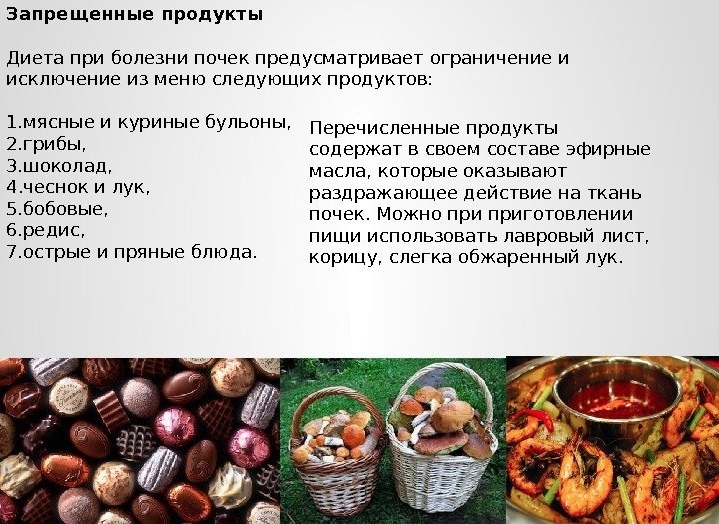
And what can be used?
As already mentioned earlier, that, depending on the disease and the severity of its course, the amount of proteins consumed, salt and fluid may vary from the patient to the patient. Therefore, consider a list of products which can be consumed, adhering to the doctor's recommendations.
- Dietary meat and fish.After all, protein products in the diet should be, but should also be easily absorbed. Therefore, only lean meat is suitable for the type of veal, low -fat beef, rabbit and chicken, turkey, as well as low -fat fish - zander, hek, sida.
- It is better to cook products for steam or boil, baking is allowed. Fry dishes are not as strictly prohibited as in diseases of the digestive system, for example with a gall bladder, but in this case, meat and fish should first boil!
Important: most of the consumption of sodium comes from salt added during food treatment. Therefore, it is so important to choose fresh meat or fish and cook with a small addition of this spice!
- Fruits, berries and vegetables.This is a group of products (we examined vegetable exceptions) does not have sodium or includes its very small share, so almost all types are allowed . The main healthy vegetables: asparagus, broccoli, carrots, cucumbers, eggplant, summer squash. Among the fruits These are: apples, all berries, peaches, pears, pineappers, tangerines and Watermelons. But it is worth highlighting the last component! It is known about its cleansing properties for the kidneys, however, they should get involved in wisely. After all, there is a load on the urinary organ.
- You can use vegetables and fruits in any form,both in fresh, frozen or steam, and in the form of fruit drinks or compotes. But if you use canned vegetables, look for options with a low salt content or without salt.
- Advice: To remove the additional amount of sodium from canned vegetables, pour the contents into a colander, rinse them under fresh water, and then prepare vegetables in more fresh water.
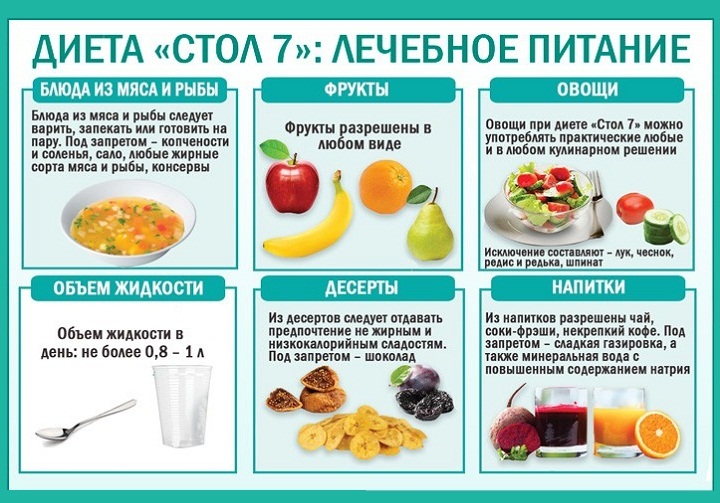
- Allowed All types of cereals! A special place should be given to buckwheat, rice porridge and sago! If you love pasta, you can afford them completely without salt!
- Eggs You can in the amount of 2 eggs per week. Ideally, in the form of a steam omelet, you can softly.
- For Bakingsalt is required, so it is better to consume bakery products with a low sodium content or without adding salt. Ideally, do it yourself!
- Be sure to include in the menu Soups and borscht But we take the vegetable broth.
- Can be used low -content seasonings sodium.In general, try to use fresh ingredients more often when cooking at home to control sodium consumption. Instead of grabbing a salt shaker, take out fresh herbs and spices to add aroma to your favorite dish. If you eat outside the house, ask to cook food without salt or select options with a low sodium content where it is possible.
- Cheese - This is the main source of calcium, but we turn on cottage cheese, cream cheese, Mozarella, Kamamber and Bree. True, these cheeses can also be consumed in limited quantities.
- Unsaturated fatty acids (for example, olive oil) and polyunsaturated fatty acids (for example, corn oil or milk thistle oil) contribute to proper nutrition for kidney disease. Generally recommended Easily digestible fats: butter, olive and vegetable oil, soy and sunflower oil.
- Beverages With a low sodium, potassium and low phosphate content, such as fruit and herbal teas, fruit and vegetable juices, compotes, green and black tea, as well as coffee, are suitable drinks for diet No. 7.
- Instead of sugar We go to honey! Instead of sweets It prefers puddings and jelly. Of sweets, marshmallows, marmalade, pastille and fruit ice cream can be.

Diet table No. 7: tips
A few tips that will help improve your health:
- Hidden sodium can be found in products that do not even have salty taste. Therefore, look for products with the inscription “with a low sodium content (140 mg or less per portion)”, “with a low sodium content” or “without adding salt” (less than 5 mg per serving). Products with 400 mg or more sodium should not be in your diet;
- More often eat fresh home dishes. Products that you cook yourself contain less sodium than most soluble, frozen and boxed mixtures;
- Be inventive and season your food with spices, herbs, lemon, ginger and vinegar;
- Remove the salt shaker from the table;
- Get out! Yes, this also applies to a diet, since the lack of sleep affects the night adrenal regeneration;
- Beware of any carbonated drinks because they contain added sodium;
- Salt substitutes are sometimes made of potassium, so read the label. If you have diet Table number 7 With a low potassium content, first consult a doctor about salt analogues;
- Arrange for yourself periodically Railing days By the type of monodite. Very useful vegetable or berry-fruit days.

Diet table No. 7: approximate menu for a week and every day
Diet table No. 7 has restrictions, but it is quite diverse. Here is a approximate power plan for the week, which follows the rules of the diet table No. 7
Important: it is very useful to drink a glass of broth from rosehips or wheat bran in the morning even before meals.
The first day of the diet
- Breakfast: rosehip tea, protein steam omelet
- Lunch: Diery coffee with homemade pastries without salt
- Dinner: vegetable soup, buckwheat porridge with boiled chicken breast - 100 g (without salt or very low salt content)
- Snack: 100 g of fresh apple, pears, watermelon or 200 g of fresh blueberries/cranberries
- Dinner: Potato mashed potatoes without salt and salad from cabbage
The second day of the diet
- Breakfast: Baked potato pancakes without salt with a cup of black coffee
- Lunch: Cheeshell with tea
- Dinner: Borsch, Bulgur with steam cutlets and fresh cucumber
- Snack: 100 g of fresh apple or cherries
- Dinner: Fresh salad with cabbage and white rice
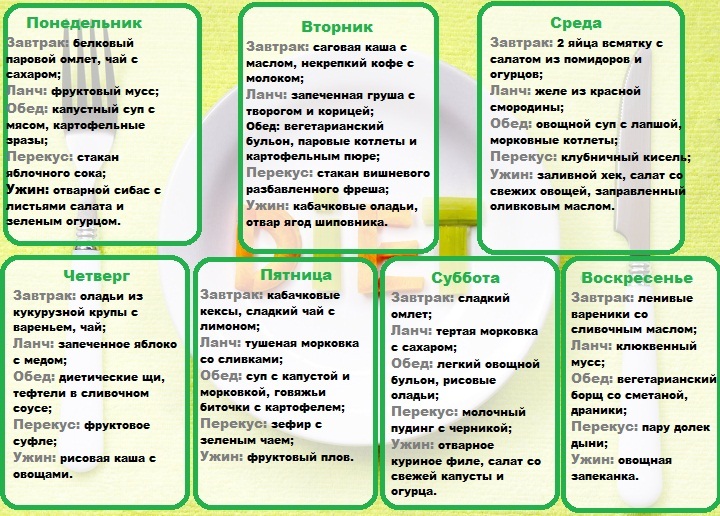
The third day of the diet
- Breakfast: Sagow porridge with a cup of simple tea
- Lunch: Home low -fat yogurt
- Dinner: cabbage and low -fat fish, steamed without salt
- Snack: 100 g of fresh pears or cherries and fruit souffle
- Dinner: vinaigrette without salty cucumbers, but with sea cabbage, a slice of bread without salt
The fourth day of the diet
- Breakfast: cottage cheese casserole and coffee
- Lunch: tea with chamomile with any allowed sweetness
- Dinner: cabbage rolls with rice and chicken breast with a minimum amount of salt
- Snack: 150 g of watermelon or raspberries
- Dinner: tomato salad and pearl barley porridge
The fifth day of the diet
- Breakfast: cottage cheese with low -fat yogurt or sour cream and sugar + tea
- Lunch: Cranberry mousse
- Dinner: Borsch vegetarian and wheat porridge with beef without salt
- Snack: 200 g of fresh blueberries
- Dinner: Baked in the oven of an asparagus with greens and low -fat glass from a veal
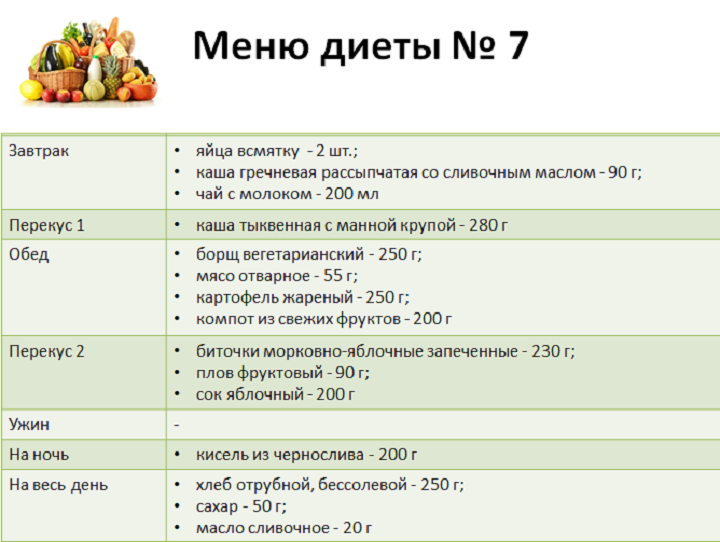
The sixth day of the diet
- Breakfast: Boiled potatoes with a cup of black coffee
- Lunch: 2 baked apples
- Dinner: Soup with chicken meatballs and corn porridge with a salad of fresh vegetables without salt
- Snack: 200 g of fresh cranberries or raspberries
- Dinner: vegetable stew, tea with chamomile
The seventh day of the diet
- Breakfast: White bread without salt (toasts can) with butter and jam + tea
- Lunch: Fresh carrots grated with sugar
- Dinner: rice soup, vegetable vehicles with fresh vegetables
- Snack: 100 g mandarin or peach
- Dinner: Home apple pie and low -fat yogurt
Diet table No. 7: recipes for popular dishes
We have already been convinced that the diet table No. 7 is very rich in various types and options for food. But the most important thing is that you need to not only reduce the dosage of salt, but also reduce meat consumption. So, it is worth learning to prepare vegetarian variants of familiar dishes or do without salty components.
As in the first recipe - vinaigrette with sea cabbage
- After all, salted cucumbers need to be excluded. Therefore, boil:
- 1 small carrots
- 3 average potatoes
- 2 small beets
- Then add:
- 50 g of sea cabbage
- 1 average cucumber
- Grind everything in a convenient way and season with greens, 1 tbsp. l. olive oil from 1 tsp. lemon juice.
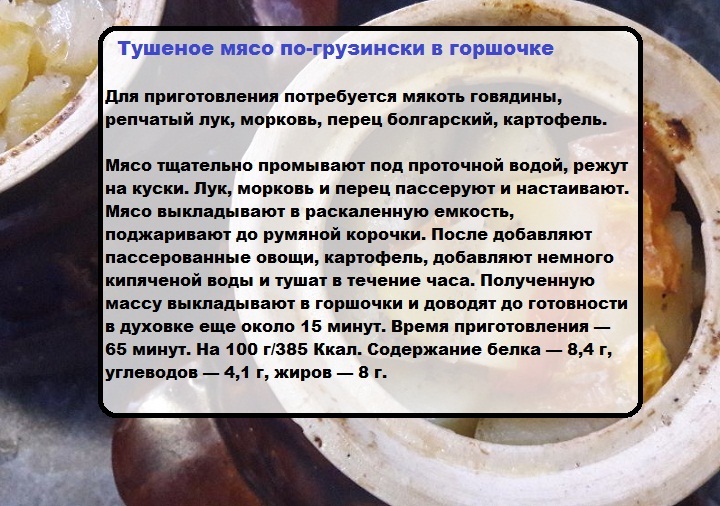
Puree soup from zucchini
- Armed:
- potatoes - 2 tubers
- zucchini - 2 pcs.
- water - 400 ml
- milk - 100 ml
- a bunch of greenery
- We throw the potatoes into already boiling water and add zucchini. Previously, do not forget to grind everything. You need to boil for 20 minutes. Then grind to the puree state using a blender. Add milk and decorate with herbs.
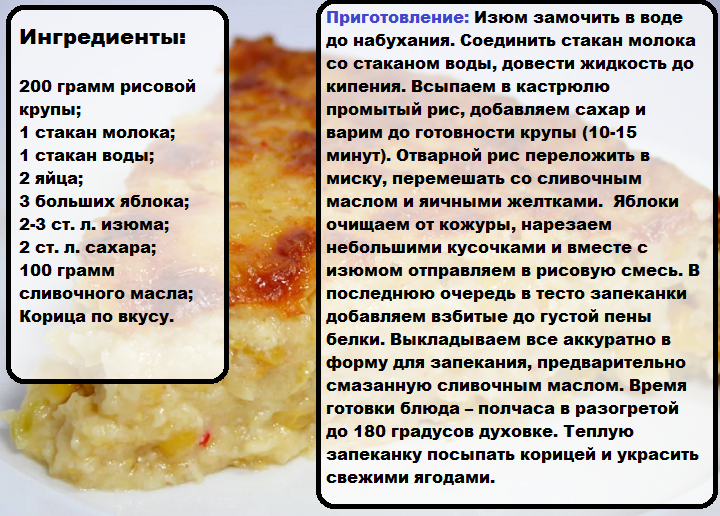
Pilaf with dried fruits
- We will need:
- a glass of rice
- 3 glasses of water
- prunes, kuraga, barberry, you can fresh apples - 100 g
- Pour all dried fruits with boiling water and hold for 20 minutes in water. Rice is well washed and also soak for half an hour. In the meantime, we clean and cut into cubes.
- We begin to cook rice, after 15 minutes we add dried fruits and apples cut into cubes. We withstand over low heat until cooked. At the very end we throw 0.5 tbsp. l. butter.
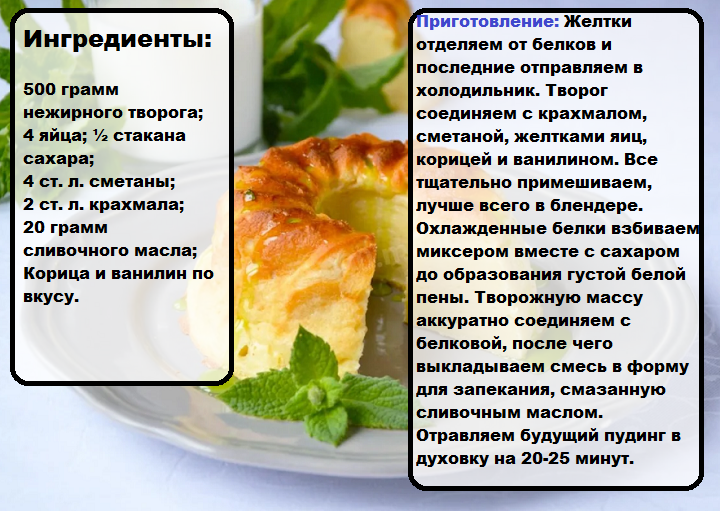
Milk jelly
- Need:
- 100 ml of milk
- 3 g of potato starch
- 10 g of sugar
- 1 yolk
- vanilin 2-3 g (optional)
- We bring to a boil half of milk with sugar and vanilla. With the second half, we make a dressing of yolk and starch. Then gradually pour the gas station into boiling milk, stirring constantly. Remove immediately from the fire!
Adhere to it diets Table number 7 Only if you have indications for its use. But it can also be observed for preventive purposes. If you notice an unusual swelling or it became difficult for you to breathe, immediately inform your nephrologist about this problem. Let your health be strong!

